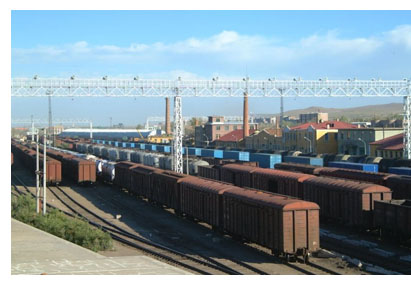Manzhouli: China’s Largest Inland Port of Entry
 Oct. 7 – Although its name is obscure, Manzhouli is an important gateway for business in Inner Mongolia and receives 60 percent of all of China’s trade to and from Russia and the rest of Eastern Europe.
Oct. 7 – Although its name is obscure, Manzhouli is an important gateway for business in Inner Mongolia and receives 60 percent of all of China’s trade to and from Russia and the rest of Eastern Europe.
It is the country’s largest inland port of entry.
Manzhouli borders the Russian city of Zabaykalsk with a free trade zone that allows residents from both sides to cross visa free.
Many Russian citizens have actually purchased property and live on the Chinese side because houses are cheaper and considered to be better made.
The combined population of the two cities is about 400,000, with 250,000 of them living on the Chinese side. Manzhouli, while small in terms of population, is an important gateway to Russia and is fast developing as a trading city.
From the early Qing Dynasty onwards the Argun River, the city became the border between the Manchu Empire and Russia. In 1901, the China Far East Railway was completed in accordance with the Sino-Russian Secret Treaty of 1896, linking Siberia, Manchuria, and the Russian Far East. A settlement then formed around Manchzhuriya Station, the first stop within Manchuria for Russians.
It was the beginning of the modern city of Manzhouli. In 1905, Manzhouli was designated a trading center in the Sino-Japanese Treaty of 1905, boosting its economic growth. In 1908, the Manzhouli customs was set up. Under China, Manzhouli came under the jurisdiction of the province of Hsingan.
It was only in 1927 that Manzhouli was officially designated as a city. Manzhouli came under Japanese control in 1931 along with Hsingan and surrounding areas and included in the Empire of Manchukuo from 1932-1945. It became part of Inner Mongolia under the People’s Republic of China in 1946.
By 1992, Manzhouli became one of the first land border cities opened up by China because of it is located directly on the most convenient train route to the Commonwealth of Independent States. The rail network here extends to as far as Beijing and continues onto Moscow with further links to Eastern Europe.
The city’s trade makes up 37 percent of total foreign trade in Inner Mongolia and 15 percent of China’s total trade with its 14 neighboring countries. The local government has adopted a series of policies to boost border trade and opened over 200 import and export companies since the city was designated as an international port of entry city in 1992.
Manzhouli’s trade has shifted from waste steel, chemical fertilizers, fruit, vegetables and garments to timber, petroleum and technology. The growing industries in the city are repackaging, warehousing, goods consolidation and distribution.
The city airport is linked to Beijing and the provincial capital of Hohhot. There are plans to develop the city’s existing export processing zone, in addition to the Free Trade Zone established in 1996. The Shangri-La Hotel chain is also set to open a 200 room hotel in the city by 2009.
This article was aggregated from the new China Briefing Regional Guide to Central China featuring the Provinces of Henan, Hubei, Hunan, Inner Mongolia, Jiangxi and Shanxi and the regional cities of Baotou, Changde, Changsha, Datong, Hohhot, Kaifeng, Louyang, Manzhouli, Nanchang, Taiyuan, Wuhan, Yichang and Zhengzhou.
The guide is priced at US$25 plus p&p. Online orders can be placed here or via email to sales@china-briefing.com
The complete China Briefing bookstore can be accessed here.
Inquiries on investment in Manzhouli can be directed to Dezan Shira & Associates at info@dezshira.com.
- Previous Article China’s Golden Week Holiday Boosts Consumer Spending
- Next Article All Foreign-Funded Companies in China to be Unionized by 2009









